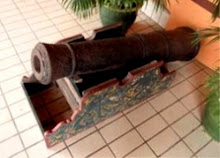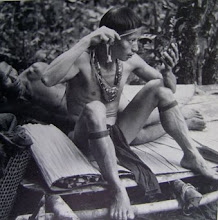THE ORIGIN OF NGERAPOH
The Death Of Garik And The Beginning Of "Ngerapoh"ln the days of Sera Gunting the son of Menggin, who led the first immigration of the Ibans from the Kapuas valley towards Sarawak, there was another man named Kadam who lived by the upper Marup River in the vicinity of Tiang Laju mountain, not far from the present town of Engkilili about 300 kilimeters from Kuching to Sibu by road..
When he was eighty years old, Kadam went to stay in his farm hut to protect his padi from being invaded by wild boars. His son Garik did not want him to go to the farm, because of his great age, but he went anyway. After several days, Garik went to visit him at the farm. But when he came to his father’s hut he found that he was not there, although all of his belongings were properly put away inside it. Garik went to another hut nearby where a woman was staying. He asked her whether she had seen his father, and she said that she had not seen him. Garik began to be worried. He stayed in is fathers hut that night, as there was not enough time before dark to return to the longhouse. He found that his father’s rice in the cooking pot had became mouldy.
Early in the next morning, after he had taken his food, he returned to the longhouse and told the people that his father was not in his farm hut. He begged for help from the people to look for his father again for avsearch and rescue. All the people in the longhouse went with him to the farm. They found that Kadam had left the hut about three days earlier. After they had looked for him around his farm hut, they walked along the edge of his padi field. At the end of a track leading not far away from it, they found his headless body, already decomposed and eaten by worms, lying in the bush. They knew that he had been killed by enemies. Strictly obeying customary procedure, Garik and his friends did not move Kadams corpse elsewhere. Tbey just let it decay on the spot.
In ancient times no Iban would touch or move away the corpse of a person who was either killed by enemies in the battle field, or murdered in a farm hut, or dead of a natural death alone in the open space. If a person was murdered as the how the way Kadam was, he could only be left to rot where he fell. Besides this, everyone was forbidden to look too long at his body. If a person died alone in a hut, the hut must be destroyed, and if a man died fighting on the road side , his corpse must be covered with leaves. All these taboos were to be observed strictly in order to prevent one from dying before ones time and another..
Some days later Kadam began to appear to many people. They saw him sitting on steep lands by the river bank, watching the people who bathed. He also appeared on the uncovered verandah at night outside the longhouse, and he often appeared at the wide space outside the longhouse in the day time. And the members of his family often heard him coming into their family room at night. He also went up to the loft, for they often noticed the marks his fingers left in the padi grains in the padi bins.
After he had appeared many times to many people, his son Garik had a dream. In it, he saw his father come and sit down on their own communal verandah (ruai). On seeing him Garik said, are you still living, father? No, I have died, replied his father. He told Garik that he lived a very hard life in the other world as he had no axe, cooking pot, clothes and other things for him to use and wear. Due to this hardship, he said, I have been wandering about as most of the time that you have seen, Garik told him that he would willingly provide these things, but he did not know where to send them. His father said, everything such as axe, knife, cooking, pot and clothes which you give me should be put inside a jar, and this jar then buried in the cemetery ground.
In the morning Garik told the people of his dream that night. As his father had told him, he placed the collection of things in a “Rapoh Jar” which he buried in the cemetery that same day. After these things had been buried, his father never again reappeared to human eyes or demanded more things in a dream.
Later it was known to Garik and the people of his house that his father had been killed by a Kantu warrior by the named Jugam who lived near the mouth of the Ketungau River. After Garik buried his fathers articles inside a “Rapoh Jar” in the cemetery, henceforth the Ibans called that kind of burial of the deceased’s belongings to be “Ngerapoh”. This system of burying articles to give them to a dead person who died far away from his own home was followed by Ibans of the past ages.
How Jiram Rentap - The Iban Warrior Have His Death "Ngerapoh"
The best example of this “Ngerapoh” burial to be recorded here was the one made by Jantan, well-known Iban Chief of the upper Paku in the Saribas District, who died in about 1839. While Jantan was an Iban Chief of the Paku watershed, his brother-in-law, Jiram whose nick-name was Rentap, was one of the leading warriors in the lower part of the same river. In the year when Jantan and his followers were farming at the Ngiau lands, they began to build a big warboat; and Jantan also asked Rentap to build another warboat as large as his. They built these boats at Ulu Ngiau in the upper Paku River.
After the boats were completed, Jantan called for a big meeting in his house, to discuss which settlement that they would attack. In this conference all the warriors appointed Rentap to become their war- leader to attack the Kanowit tribe on the Rejang River. They did not want to waste time attacking the people of Sarikei and Binatang Rivers who had been regularly attacked by Mujah Buah Raya of the. Julau and Igoh Apai Lamban of Ulu Binatang. These two war chiefs were Saribas migration leaders who had settled in those parts of the settlement. Jantan doubted whether it was safe to pass so many hostile people in the Rejang River on their way to attack the Kanowit tribe, who lived along the right river bank of the Kanowit River near its mouth. But in spite of Jantan’s hesitation all the warriors were determined to attack with Rentap as their leader. At the conclusion of the agreement Jantan and Rentap invited all the Paku and Anyut warriors as far as the people of Nanga Salamoi down river to join the war expedition (Ngayau).
Hearing that the Paku Ibans under Rentap were preparing to raid the Kanowit tribe, the Bukitans who lived in the Julau River sent messages to warn the Kanowits of the coming attack. When they received the message, the Kanowits instantly called the Rejang people to come and reinforce them. After the arrival of the Rajang’s the warriors of the two tribes started to fortify themselves in many different ways. They collected two long semambu canes which they placed across the rivers, below the surface of the water, at Nanga Kanowit. Both ends of these canes were tied to big trees, whose lower trunks had been partly cut so that they could be felled quickly when the enemys boats passed them.
Early the next morning when it was still dark Rentap’s and Jantan’s boats entered the Kanowit River. When they passed above those canes, the Kanowit warriors cut through the trees which lifted up the canes turning the boats upside down. Rentaps and Jantans boats were instantly capsized, and all the warrior’s weapons were lost in the river. The Iban fighters swam to the shores to save themselves. But when they landed they were attacked by the enemy who killed them easily as they had no more weapons with them to defend themselves. Out of all these warriors only very few could escape to the jungle to save themselves.
As they fled aimlessly in the forest, Rentap and many others died of starvation at Nanga Pakan in the Julau River. Before he died Rentap told his brother-in-law Jantan to lead the survivors returned back to their Paku settlement. He also asked him to look after the welfare of his wife and particularly to help bring up his fatherless children. After Jantan and his friends had buried Jiram ‘Rentap’ in the ground they left the place and wandered through the forests, seeking the way home. Eventually when they came to the range of hills between the Julau and Krian rivers, they were able to see in the distance the summit of Bukit Tengalat on the left bank of the lower Krian below Nanga Melupa. On seeing this they knew where they were. The walked towards it and crossed the Krian river; from Tengalat hill they went to the Rimbas, and so returned to their home in the Paku river.
On their arrival home, Jantan told the people about their defeat by the Kanowits. All were sad to hear of this tragedy. Jantan and the other elders thought it was proper to honour the death of Jiram ‘Rentap’ and his deceased warriors with the ‘Ngerapoh” burial in accordance with the custom begun by Garik when he buried the articles of his father, Kadam, killed by the enemy long ago. The place where Rentaps and his warrior’s rapoh were buried was on and around the top of Bukit Rapoh, near the Danau longhouse in the upper Paku. Today a number of the jars that were used can still be seen at that spot.

































No comments:
Post a Comment